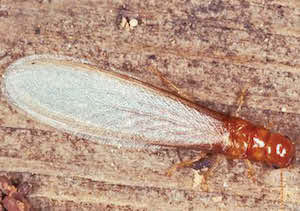WHAT DO drywood termites LOOK LIKE

The size of drywood termites, Incisitermes minor (Blattodea: Kalotermitidae) varies, depending on their age, from 1/4 inch to 1 inch long. Adult drywood termites have a thicker, oval-shaped waist, short legs and straight antennae that appear like a string of pearls. Like all termites, their hind wings and fore wings are equal in length. They are usually cream-white to light brown in color, unless swarming in which case they are a bronzing reddish color. Unlike the more common Subterranean termite in the Mid-Atlantic and Northeastern US, the drywood termite is able to infest wood without having to be linked to soil or a source of moisture. They can infest free-standing furniture just fine!
Drywood termites form colonies of up to 2,500 members. Unlike subterranean termite species, drywood termite colonies do not have a worker caste, as the work is done by immature termites before they reach adulthood. You may see drywood termite swarmers (fliers) on sunny, warm days after a sudden rise in temperature. However, they are often noticed by the unique droppings, called “frass”, that fall out of colony holes in the wood they infest. Each frass pellet has six flattened or concavely depressed sides. Also, unlike subterranean termites, drywood termites can infest wood materials like furniture that is not in contact with the soil as they do not require a source of moisture like other termites get from soil.
Drywood termites form colonies of up to 2,500 members. Unlike subterranean termite species, drywood termite colonies do not have a worker caste, as the work is done by immature termites before they reach adulthood. You may see drywood termite swarmers (fliers) on sunny, warm days after a sudden rise in temperature. However, they are often noticed by the unique droppings, called “frass”, that fall out of colony holes in the wood they infest. Each frass pellet has six flattened or concavely depressed sides. Also, unlike subterranean termites, drywood termites can infest wood materials like furniture that is not in contact with the soil as they do not require a source of moisture like other termites get from soil.